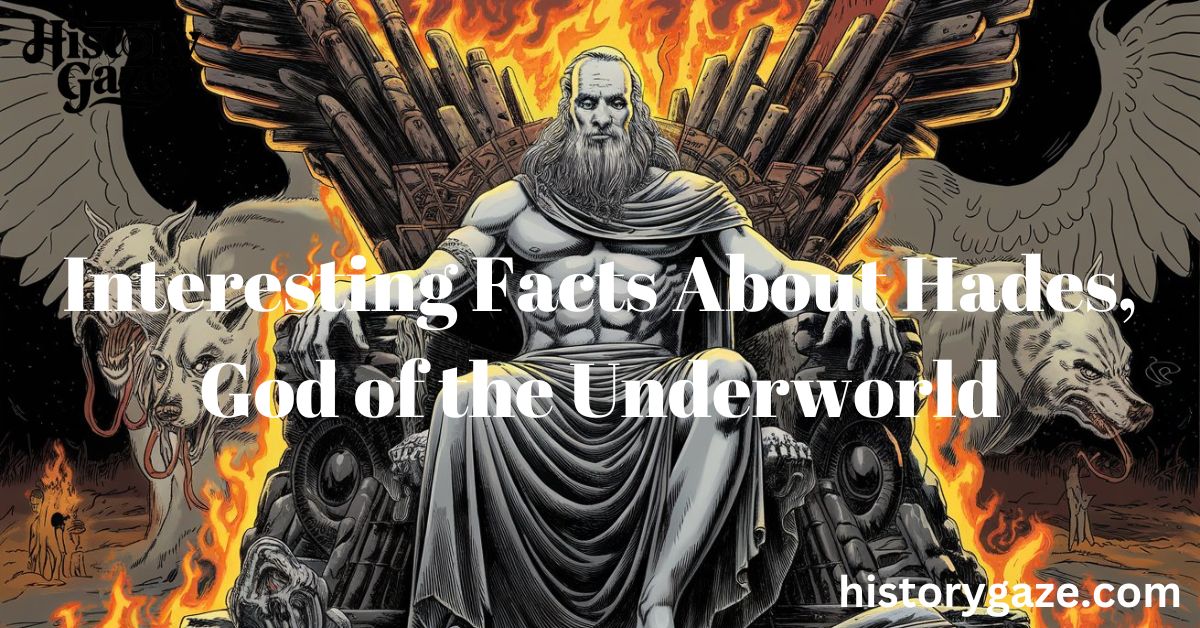Hades, the Greek god of the Underworld, is one of the most enigmatic and misunderstood figures in Greek mythology. While often portrayed as sinister or evil in modern culture, the ancient Greeks viewed Hades quite differently. As the ruler of the realm of the dead, his role was essential in maintaining balance in the cosmos. This blog post will explore interesting facts about Hades, God of the Underworld, that shed light on his role, personality, and influence in the Greek pantheon.
The Eldest of the Olympian Brothers
Hades was the firstborn of the Olympian gods. Cronus and Rhea, his parents, were part of the first generation of gods in Greek mythology. This makes Hades the older brother of Zeus and Poseidon. Though many often think of Zeus as the leader of the gods, it is interesting to note that Hades, being the eldest, holds a unique place in the hierarchy.
The irony here is that despite his status as the oldest, Hades did not inherit the earth or sky. Instead, after the defeat of their father Cronus, he and his brothers divided the cosmos, and Hades drew the lot that gave him the Underworld.
A Tragic Beginning: Swallowed at Birth
In Greek mythology stories, the birth of Hades was fraught with danger. According to legend, Cronus feared a prophecy that one of his children would overthrow him, so he swallowed Hades, along with his siblings. They remained trapped inside their father until Zeus, the youngest brother, rescued them by forcing Cronus to regurgitate them.
This act of rescue not only highlights the importance of Hades but also sets the stage for the long-standing dynamics between the three brothers: Zeus, Poseidon, and Hades.
Ruler of the Underworld After the Titanomachy
Hades’ rise to power came after the Titanomachy, a great war between the Olympian gods and the Titans. Following the gods’ victory, Hades, Zeus, and Poseidon drew lots to divide the realms. Hades received dominion over the Underworld, Zeus over the heavens, and Poseidon over the sea.
However, Hades’ Underworld is not a place of pure torment. It consists of several regions, each serving a different purpose:
Hades’ kingdom reflects the Greek concept of justice: those who were good in life are rewarded, while those who were evil are punished. It’s a balanced system, unlike the more chaotic and emotional nature of the gods who rule above ground.
Not the God of Death, But its King
A common misconception is that Hades himself is the god of death, but this title belongs to Thanatos. Hades rules the Underworld and presides over the souls of the dead, but he doesn’t personify death. Instead, he is a more neutral figure, focused on maintaining balance and order in his domain.
The ancient Greeks didn’t necessarily fear Hades himself. Instead, they viewed him with a certain respect and reverence. His role was crucial in the cycle of life and death, and he ensured that the souls of the dead reached their appropriate destination.
The Distinction Between Hades and Thanatos
Thanatos, the god of death, works more like a psychopomp, escorting souls to the Underworld. Hades’ role begins once those souls arrive. He ensures that each soul is judged and sent to the correct realm, whether it be the Elysian Fields, Tartarus, or the Asphodel Meadows.
Rarely Considered One of the Olympians
Despite his power, lists of the twelve Olympian gods often exclude Hades. The reason for this is simple: Hades rarely left the Underworld. His dominion kept him busy, and unlike his brothers, he wasn’t fond of meddling in the affairs of humans or gods on Mount Olympus.
Hades’ introverted nature and focus on the Underworld make him a fascinating contrast to the often more flamboyant and impulsive gods like Zeus or Ares. His realm required constant attention, and Hades was diligent in ruling it.
The Three Headed Guard Dog
Perhaps one of the most iconic symbols of Hades’ Underworld is his pet, Cerberus, the three-headed dog. Cerberus guarded the gates of the Underworld, ensuring that the dead could not leave and that the living could not enter.
Each of the heads of Cerberus represents a different aspect of the past, present, and future—symbolizing the inevitability of death and the fate that awaits all mortals.
In many Greek mythology stories, Cerberus features in various myths, most famously in the tale of Heracles, who must bring the beast to the surface as one of his Twelve Labors.
Queen of the Underworld
Hades abducted Persephone, Demeter’s daughter, to make her his queen.This act set off a chain of events that influenced the very seasons.In grief, Demeter caused the Earth to become barren until she allowed her daughter to return.
Yet, as time passed, Persephone grew into her role as Queen of the Underworld. While the initial abduction was against her will, Persephone became a powerful figure in her own right, ruling alongside Hades.
Persephone’s Influence on the Seasons
When Persephone returns to the Earth for part of the year, spring and summer begin, reflecting the joy of Demeter. When she descends to the Underworld, autumn and winter take hold, symbolizing Demeter’s sorrow.
Persephone is a unique figure in Greek mythology because she embodies both life and death. As Hades’ queen, she ensures that the cycle of life continues, even from within the Underworld.
Father to Mysterious Offspring
Hades and Persephone are said to have had children, though these figures are rarely mentioned in the most popular myths. One notable daughter is Melinoe, a goddess associated with ghosts and the restless dead. Another is Zagreus, a figure who is sometimes depicted as a god of rebirth.
Hades’ children may not be famous, but they show the quiet power and mystery of Hades and Persephone as rulers of the dead.
Persephone’s Dual Role and Their Equal Partnership
Unlike many of the other gods, Hades and Persephone ruled together as equals.Their relationship did not involve the constant infidelity and power struggles that are seen in the relationships of other gods, such as Zeus and Hera.
This mutual respect is one of the more unusual aspects of Greek mythology stories. Persephone’s power is acknowledged, and together, they maintain the balance in the Underworld, ensuring justice for the souls of the dead.
The Vast and Complex Nature of the Underworld
The Underworld is far more complex than many believe.It’s not just a place of darkness and despair; it has regions for different souls.
The Underworld also features the River Styx, a boundary between the world of the living and the dead. Charon, the ferryman, transports souls across this river, a role that is crucial to the entire structure of the afterlife.
A Just and Balanced Ruler
Despite his fearsome reputation, Hades often shows fairness as a ruler. He isn’t evil; he simply maintains order in the Underworld. He treats the souls of the dead fairly, whether they were saints or sinners in life.
Unlike some of the more volatile gods, Hades values peace and balance.He rarely intervenes in the affairs of the living and isn’t as quick to anger or jealousy as Zeus or Hera.
“Zeus Katachthonios” Hades’ Other Name
Hades is sometimes referred to as “Zeus Katachthonios,” meaning “Zeus of the Underworld.” This name highlights his equal power to Zeus, despite ruling a different realm.
It also reflects the ancient Greek belief that Hades had authority over both life and death. His role was as significant as that of Zeus, though his domain was less visible to the living.
The Helm of Darkness: A Gift of Invisibility
One of the most famous artifacts associated with Hades is his Helm of Darkness (also known as the Cap of Invisibility). This helm allowed Hades to become invisible to both mortals and gods. He used this powerful item during the Titanomachy, assisting his brothers in their battle against the Titans.
The gods also lent the helm to heroes like Perseus, who used it in his quest to slay Medusa. This shows that Hades, despite his isolation in the Underworld, was willing to support and assist heroes when needed.
The Forbidden Names
In ancient Greece, it was considered dangerous to speak Hades’ name aloud. People believed that invoking his name could attract his attention and bring misfortune. Instead, euphemisms like “The Wealthy One” (Plouton) were used to refer to him.
This fear of Hades and his wife Persephone reflects the ancient Greek understanding of death as an unavoidable, yet intimidating, aspect of life. By avoiding their names, the Greeks hoped to delay the inevitable.
Hades’ Connection to Wealth
Hades both ruled the dead and associated himself with wealth. Known as Plouton by the Greeks, Hades governed all the precious minerals and resources found underground. This connection to riches further reinforced his role as a god of both death and earthly wealth.
People often misunderstand Hades in Greek mythology. He was more than just the god of the dead. Hades played a key role in balancing life and death, wealth and decay, and order and chaos. He wasn’t just a villain. Hades was a fair and strong ruler, important to the ancient world’s structure.
Hades and His Role in the Mysteries
One of the lesser-known aspects of Hades’ influence is his connection to ancient religious rites, particularly the Eleusinian Mysteries. These secret ceremonies, dedicated to Demeter and Persephone, explored themes of death and rebirth.Hades wasn’t worshipped directly in these rites. However, as the ruler of the Underworld, he was important for explaining life and the afterlife. The mysteries aimed to help people understand this cycle. Initiates believed that knowing these secrets could lead to a better afterlife. This showed that Hades’ domain was not only a place of suffering but also of renewal.
The Rivers of the Underworld
The Underworld is not just defined by its dark realms like Tartarus or the Asphodel Fields, but also by the five rivers that flow through it, each representing different aspects of death and the afterlife. These include the Styx, associated with unbreakable oaths; the Lethe, tied to forgetfulness; the Acheron, the river of woe; the Cocytus, the river of lamentation; and the Phlegethon, the river of fire. Hades’ control over these rivers signifies his deep connection to the different emotional and physical states souls encounter after death, showcasing the depth of his rule.
Hades’ Symbols and Iconography
In Greek mythology, Hades is often depicted with specific symbols that represent his power and authority. The most recognizable of these is the bident, a two-pronged spear, similar to Poseidon’s trident. His Helm of Darkness is another iconic object, granting him the ability to become invisible to both mortals and gods. Additionally, Hades’ throne is said to be made of ebony, a rare and dark wood that underscores his somber yet regal nature. These symbols not only identify Hades but also speak to his unique position as ruler of the Underworld.
Hades and His Rare Interactions with Heroes
Unlike his more meddlesome siblings, Hades rarely interacts with the heroes of Greek mythology stories.When Hades does intervene, his actions have a lasting impact. He allowed Orpheus to enter the Underworld to retrieve his wife, Eurydice, but his conditions led to failure. Similarly, Theseus and Pirithous attempted to kidnap Persephone but Hades imprisoned them in the Underworld for their audacity. These stories show that while Hades generally detached himself from the mortal world, mortals were not to cross him.
Hades’ Legacy in Modern Culture
Even today, Hades remains one of the most recognizable figures from Greek mythology, often portrayed in literature, films, and video games. While modern depictions sometimes lean into the idea of Hades as a villain, his original portrayal as a fair and just ruler remains intact in more faithful retellings. From Disney’s Hercules to video games like Hades, the Greek god of the Underworld continues to captivate audiences, proving that his complex character and important role in mythology still resonate in popular culture.
Conclusion
In conclusion, Hades, the Greek god of the Underworld, was a complex figure. He had a role in mythology that went beyond just ruling the dead. His kingdom, relationships, and power are important in Greek myths. Hades managed different realms like the Elysian Fields, Asphodel Fields, and Tartarus. He was a fair ruler who oversaw the cycle of life and death.

Chloe Decker is a skilled writer for History Gaze, passionate about making history engaging and accessible. She brings the past to life with clear, concise narratives that appeal to both history lovers and casual readers. Through her work, Chloe reveals the key events and figures that shaped the world, helping readers connect with history in a meaningful way.











